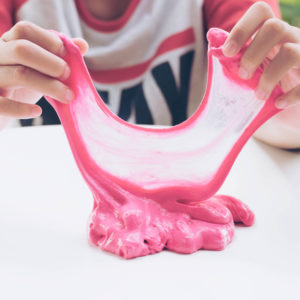As the holiday revelry begins, self-proclaimed “consumer advocates” have sounded the alarm about so-called “toxic toys”—toys that supposedly contain dangerous chemicals. But don’t let them get your spirits down, because their findings are simply not credible, and following their advice could burn a hole your pocketbook faster than the Heat Miser.
Near the top of the naughty list is the U.S. Public Interest Research Group (USPIRG) annual “Trouble in Toyland” report. This year, they focus on “toy slime,” saying it contains dangerous levels of boron.
Boron, however, is simply a mineral, which occurs naturally in many foods—from nuts to broccoli to potatoes. Some people even take boron supplements. Overconsuming boron could produce adverse effects, including inflammation, headaches, and gastrointestinal distress, but low levels are not necessarily a concern.
Chemist Rich Sachleben told CNN in November that the type of boron found in slime has “very low toxicity,” and a child would have to consume “multiple containers” before they get sick. “The health risks are relatively low and can be controlled by telling your kid: ‘If you eat the slime, I’m not going to buy you any more,’” Sachleben said.
USPIRG also suggests that parents avoid all makeup products for kids because it claims to have found asbestos in Claire’s makeup in 2017, alleging the company used contaminated talc as an ingredient. Talc is a mineral mined in areas where asbestos might also be present, and researchers reported finding some asbestos fibers in talc in the 1970s. Since then, companies test to ensure they provide a pure and safe product. The U.S. Food and Drug Administration (FDA) conducted tests during 2009-2010 that found cosmetic grade talc and consumer products were asbestos free.
Claire’s denies USPIRG’s claims, explaining that it tested its products at four different labs in cooperation with the FDA, Health Canada, and EU enforcement agencies, and none of the samples contained asbestos. Claire’s maintained that the lab USPIRG used relied on “obsolete and unreliable” testing methods, and it was “not certified to perform the type of testing necessary for talc-based products.”
Talc is currently in the news because trial lawyers are seeking big payouts based on inconclusive science related to talc and cancer. But as the American Cancer Society (ACS) notes on its website: “No increased risk of lung cancer has been reported with the use of cosmetic talcum powder.” ACS does note that some studies find weak associations between talcum powder use in the genital area and ovarian cancer, but these do not prove cause and effect. Many other larger and more robust studies report no association.
Another example of alarmist hype is found at GimmetheGoodStuff.org, which sells alternatives—at much higher prices—to allegedly “bad” toys. The site includes a cheat sheet selecting “good” vs. “bad” toys. A comparison of prices for these products sold at Amazon.com (and one at K-Mart.com) revealed the “bad stuff” would cost $101.41 compared to $240.33 for the “good” alternatives. This estimate excludes the final item on both lists, because the two are not comparable products.
Despite higher prices, the “good stuff” isn’t necessarily safer.
For example, several items are on the “bad” list simply because they are plastic and might contain phthalates—chemicals that make plastics soft and pliable. But few toys with phthalates even exist on the market these days, since activist fearmongering led Congress and the Consumer Product Safety Commission to restrict phthalates use for toys.
Still, phthalates’ use in plastics isn’t dangerous. Environmental activists allege these chemicals are “endocrine disrupters” that can create developmental and other health problems for children. In reality, phthalates are too weak and exposure is too low to produce any measurable health impacts. Consider the fact that soy and many legumes contain similar endocrine mimicking substances, and these naturally forming chemicals are tens of thousands of times more potent than phthalates. Yet humans—and even babies—regularly consume them as part of a healthy diet without ill effect.
Ironically, the alternatives to plastic products are much heavier wood products that may be more dangerous if kids throw them around.
In another twist, Hasbro’s Play-Dough is on the “bad” list simply because its recipe is proprietary. (Hasbro notes that it’s primarily water, salt, and flour.) The suggested alternative, Eco-Kids Dough, is probably mostly the same, except it’s more than twice the price per ounce. In addition, some batches of Eco-Kids Dough reportedly quickly became moldy, according to consumer reviews at Amazon.com and Target.com—not good from a safety perspective.
So go ahead and haul out the holly with joy, and don’t fret about so-called “toxic toys.” The only thing that’s truly toxic this holiday season is the greens’ expensive advice.

